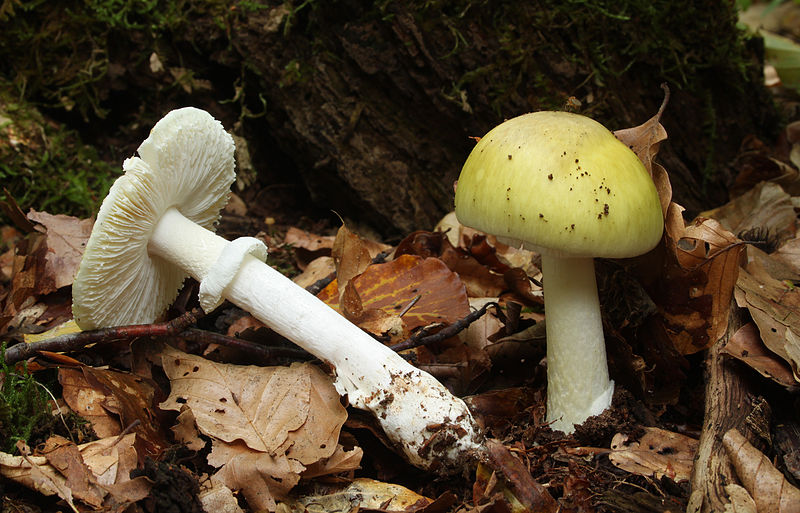Deathcap mushrooms: “The south-east Asian Problem”
- Complaining about the Mainland - 17th August, 2024
- New island designation – is it just greenwash? - 26th April, 2024
- Police and Crime Commissioners – a solution or a problem? - 21st April, 2024
This week saw the inquest into the death of a woman on the Isle of Wight who ate the deathcap mushroom Amanita phalloides and died.
Amphon Tuckey died in 2008, two days after eating a meal of cooked Amanita with her sister-in-law and niece, Mrs Kannika Tuckey, who survived despite becoming gravely ill. Both women were from Thailand. Deathcaps are responsible for 90% of all fatal mushroom poisonings in the UK and are said to have caused the deaths of both Roman Emperor Claudius in 54AD and Holy Roman Emperor Charles VI in 1740. They look innocuous enough, are pleasant to eat, and once you’ve eaten enough – and a small amount is enough – you’re highly likely to die an unpleasant death and no treatment will save you. But despite this common fungus growing pretty much everywhere, incidents of Amanita poisoning, let alone deaths, are almost unknown.
So what went wrong? Why did Mrs Tuckey die? Back in 2008 when this incident occurred, I was indirectly involved, as it involved a wild species (possibly) on council land. At that time I had do do some very quick research into Amanita poisoning and the risks thereof to satisfy concerned senior types who were advocating the immediate elimination of all fungi in public places and other such unachievable goals. Whilst I was easily able to calm down the over-reactors, something else I discovered on the way was very interesting. Now the inquest is over and done with I thought it might be time to bring it out. It has something to do with Mrs Tuckey’s country of origin. Whilst looking into Amanita poisoning I read a website called Americanmushrooms.com. Author David Fischer, in the context of Amanita, wrote about what he termed “The Southeast Asian Problem”:
Most victims of life-threatening mushroom poisoning in North America are people from Southeast Asia: Laos, Cambodia, Thailand, Viet Nam. They apparently mistake Death Caps for edible “Paddy-Straw” (Volvariella volvacea) mushrooms. The Paddy Straw mushroom is especially common in Southeast Asia; the Death Cap, alas, does not occur in Southeast Asia, so folks from that part of the world are unaware of the lethal “look-alike.” The Death Cap should be sought in every part of North America where Norway spruce or cork trees have been cultivated. If found, its presence should be publicized locally, regionally, and nationally to reduce the risk of further tragedies. It is especially vital to educate communities of south-east Asian immigrants about this lethal mushroom.
This hypothesis is backed up by others, such as American mycologist Thomas J. Duffy, MD on his website, Mycoweb. Duffy writes:
Americans of Asian extraction are poisoned more frequently than the general population because the amanitas involved resemble edible Asian species: the often off-white Amanita princeps and Amanita chepangiana.
This is of interest in the sad case of Amphon Tuckey. It is particularly pertinent because of the circumstances surrounding her death. In fact, as the inquest revealed, Mrs Tuckey did not tell her husband or the medical staff treating her about the mushrooms, and accordingly she was treated for gastroenteritis. What is more, discussing the case with those involved afterwards, nobody was aware of the connection between south-east Asians and Amanita poisoning. If they had been, possibly there would have been a different response, although as the coroner remarked: “Mrs Tuckey probably misled her husband and the ambulance crew… But the amount she had digested meant she would have died anyway.” It’s impossible to say whether anything else could have been done, but I understand that Mrs Tuckey had been collecting mushrooms and eating them for a while before the fatal incident. So conceivably, if anyone known to her knew about the link between Thai people and Amanita poisoning, they might have warned her about the danger.
It’s possible that this issue has come to light in America because there are more south-east Asian immigrants in the US than there are in Europe. The link seemed to be unknown to those involved in the Tuckey case, and I suspect is not widely known elsewhere in England. It’s hard to know how such a specific message can be broadcast, but maybe if you know anyone from a south-east Asian background, you could let them know of the risks of collecting wild mushrooms.

